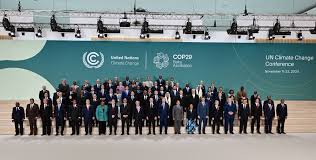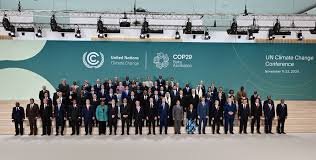
The global dialogue on climate action has reached a critical turning point. As nations work urgently to cut greenhouse gas emissions and strengthen food security, transforming food systems has become a pressing priority. At COP29 in Baku, leaders and sustainability advocates emphasized a frequently overlooked yet vital component: the “hidden middle” of agri-food chains.
“Our collective goal is to develop policies, technologies, financial mechanisms, and partnerships that bring visibility to this crucial but underappreciated segment.”
This midstream sector, which encompasses processing, packaging, storage, transportation, and distribution, plays a pivotal but often underestimated role in food systems. Although it is responsible for around 18% of food-related emissions, it generates up to 40% of the sector’s economic value.
“Neglecting the hidden middle is like ignoring a key piece of the sustainability puzzle,” says Lars Holmquist, Executive Vice President of Sustainability at Tetra Pak. “While conversations about food systems usually focus on agriculture or consumption — the beginning and end of the chain — this overlooked middle segment has significant potential to impact both the environment and the economy. Strengthening the hidden middle is not merely an option; it’s essential for building sustainable, resilient, and equitable food systems.”
According to the Food and Agriculture Organization (FAO), nearly one-third of food produced globally is lost or wasted every year. Investing in midstream infrastructure and technologies can significantly cut these losses, enhance resource efficiency, and increase the availability of food. It can also drive economic growth by creating jobs, supporting urban and rural livelihoods, and integrating smallholder farmers and marginalized communities into value-added activities.
Why the Hidden Middle Lacks Sufficient Funding
The hidden middle bridges the gap between farms and consumers, ensuring that raw agricultural products are transformed into safe, nutritious food. Despite its critical function, it receives minimal attention and funding. Food systems account for roughly 30% of global greenhouse gas emissions, yet only 2.5–4% of climate finance is allocated to this sector. Small and medium-sized enterprises (SMEs) in the midstream face a staggering $106 billion financing gap worldwide, leading to inefficiencies, food loss (up to 14% globally), and bottlenecks throughout the supply chain.
“One challenge is that measuring emissions and efficiency across a complex network of stakeholders is not straightforward,” Lars explains. “But this is exactly where we have the greatest opportunity to reduce emissions and improve food systems.”
Unlocking Opportunities in the Hidden Middle
Tapping into the potential of the hidden middle could be a game-changer for meeting global climate objectives. Studies suggest that addressing inefficiencies and emissions within this segment could deliver up to 20% of the reductions needed to meet the Paris Agreement targets by 2050.
Improved midstream infrastructure could also dramatically cut food loss and boost food access, particularly in developing regions where up to 40% of food is lost after harvest due to inadequate cold storage and transportation. Innovations like aseptic and smart packaging can help prevent spoilage and ensure food safety during transport.
“We are actively working to enhance midstream infrastructure in vulnerable areas by partnering with local authorities and organizations,” says Lars. “Our renewable-powered cold chain solutions have helped reduce food loss and improve food security where such systems are scarce. At COP29, we reaffirmed our commitment to advancing sustainable packaging and energy-efficient processing technologies to strengthen this vital sector.”
On the production side, resource optimization within factories also plays a key role. Tetra Pak’s OneStep UHT milk line, which integrates multiple processes (such as separation, blending, and heat treatment) into one, significantly reduces equipment usage and energy consumption. For example, Mengniu’s Ningxia dairy facility — recognized by the World Economic Forum as a “Lighthouse Factory” — has cut operating costs by 32% and lead times by 55% thanks to Tetra Pak’s technology.
Bridging the Investment and Policy Gap
Unlocking the full potential of the hidden middle requires targeted policies, incentives, and public-private collaboration. Measures like subsidies for midstream innovations or tax breaks for sustainable practices can help direct funding where it is most needed.
“Our mission is to drive meaningful change in food systems by uniting policymakers, industry leaders, NGOs, and international organizations,” Lars emphasizes. “We’re committed to fostering dialogue and collaboration to spotlight this overlooked but vital link in the chain.”
As countries revise their Nationally Determined Contributions (NDCs) ahead of 2025, the hidden middle offers a unique opportunity to align policies with climate goals and secure the necessary investments. Public-private partnerships will be essential to scaling infrastructure, innovation, and technology.
“Achieving progress in this area will ensure that the hidden middle operates more efficiently, helping to cut emissions, support livelihoods, and improve food security across the globe.”
Looking Ahead to COP30 in Brazil
The outcomes of COP29 have set a strong foundation for accelerating the transformation of food systems. Tetra Pak remains dedicated to advancing sustainability within the hidden middle — from renewable-powered equipment to packaging solutions that extend food shelf life and reduce waste across the supply chain.
“With COP30 in Belem, Brazil, approaching, there’s a growing push for policies and funding initiatives to strengthen midstream infrastructure,” Lars notes. “This momentum gives hope that the hidden middle will soon play its rightful role in shaping a sustainable and resilient global food system.”
“Our collective goal is to develop policies, technologies, financial mechanisms, and partnerships that bring visibility to this crucial but underappreciated segment.”
This midstream sector, which encompasses processing, packaging, storage, transportation, and distribution, plays a pivotal but often underestimated role in food systems. Although it is responsible for around 18% of food-related emissions, it generates up to 40% of the sector’s economic value.
“Neglecting the hidden middle is like ignoring a key piece of the sustainability puzzle,” says Lars Holmquist, Executive Vice President of Sustainability at Tetra Pak. “While conversations about food systems usually focus on agriculture or consumption — the beginning and end of the chain — this overlooked middle segment has significant potential to impact both the environment and the economy. Strengthening the hidden middle is not merely an option; it’s essential for building sustainable, resilient, and equitable food systems.”
According to the Food and Agriculture Organization (FAO), nearly one-third of food produced globally is lost or wasted every year. Investing in midstream infrastructure and technologies can significantly cut these losses, enhance resource efficiency, and increase the availability of food. It can also drive economic growth by creating jobs, supporting urban and rural livelihoods, and integrating smallholder farmers and marginalized communities into value-added activities.
Why the Hidden Middle Lacks Sufficient Funding
The hidden middle bridges the gap between farms and consumers, ensuring that raw agricultural products are transformed into safe, nutritious food. Despite its critical function, it receives minimal attention and funding. Food systems account for roughly 30% of global greenhouse gas emissions, yet only 2.5–4% of climate finance is allocated to this sector. Small and medium-sized enterprises (SMEs) in the midstream face a staggering $106 billion financing gap worldwide, leading to inefficiencies, food loss (up to 14% globally), and bottlenecks throughout the supply chain.
“One challenge is that measuring emissions and efficiency across a complex network of stakeholders is not straightforward,” Lars explains. “But this is exactly where we have the greatest opportunity to reduce emissions and improve food systems.”
Unlocking Opportunities in the Hidden Middle
Tapping into the potential of the hidden middle could be a game-changer for meeting global climate objectives. Studies suggest that addressing inefficiencies and emissions within this segment could deliver up to 20% of the reductions needed to meet the Paris Agreement targets by 2050.
Improved midstream infrastructure could also dramatically cut food loss and boost food access, particularly in developing regions where up to 40% of food is lost after harvest due to inadequate cold storage and transportation. Innovations like aseptic and smart packaging can help prevent spoilage and ensure food safety during transport.
“We are actively working to enhance midstream infrastructure in vulnerable areas by partnering with local authorities and organizations,” says Lars. “Our renewable-powered cold chain solutions have helped reduce food loss and improve food security where such systems are scarce. At COP29, we reaffirmed our commitment to advancing sustainable packaging and energy-efficient processing technologies to strengthen this vital sector.”
On the production side, resource optimization within factories also plays a key role. Tetra Pak’s OneStep UHT milk line, which integrates multiple processes (such as separation, blending, and heat treatment) into one, significantly reduces equipment usage and energy consumption. For example, Mengniu’s Ningxia dairy facility — recognized by the World Economic Forum as a “Lighthouse Factory” — has cut operating costs by 32% and lead times by 55% thanks to Tetra Pak’s technology.
Bridging the Investment and Policy Gap
Unlocking the full potential of the hidden middle requires targeted policies, incentives, and public-private collaboration. Measures like subsidies for midstream innovations or tax breaks for sustainable practices can help direct funding where it is most needed.
“Our mission is to drive meaningful change in food systems by uniting policymakers, industry leaders, NGOs, and international organizations,” Lars emphasizes. “We’re committed to fostering dialogue and collaboration to spotlight this overlooked but vital link in the chain.”
As countries revise their Nationally Determined Contributions (NDCs) ahead of 2025, the hidden middle offers a unique opportunity to align policies with climate goals and secure the necessary investments. Public-private partnerships will be essential to scaling infrastructure, innovation, and technology.
“Achieving progress in this area will ensure that the hidden middle operates more efficiently, helping to cut emissions, support livelihoods, and improve food security across the globe.”
Looking Ahead to COP30 in Brazil
The outcomes of COP29 have set a strong foundation for accelerating the transformation of food systems. Tetra Pak remains dedicated to advancing sustainability within the hidden middle — from renewable-powered equipment to packaging solutions that extend food shelf life and reduce waste across the supply chain.
“With COP30 in Belem, Brazil, approaching, there’s a growing push for policies and funding initiatives to strengthen midstream infrastructure,” Lars notes. “This momentum gives hope that the hidden middle will soon play its rightful role in shaping a sustainable and resilient global food system.”


 Unlocking the Hidden Middle: Transforming Food Systems for Climate and Sustainability
Unlocking the Hidden Middle: Transforming Food Systems for Climate and Sustainability




 Companies
Companies